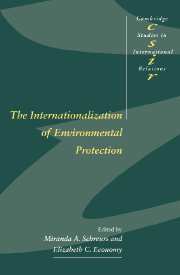Book contents
- Frontmatter
- Contents
- List of contributors
- Preface
- 1 Domestic and international linkages in environmental politics
- 2 Chinese policy-making and global climate change: two-front diplomacy and the international community
- 3 The domestic politics of global biodiversity protection in the United Kingdom and the United States
- 4 Domestic and international linkages in global environmental politics: a case-study of the Montreal Protocol
- 5 The internationalization of environmental protection in the USSR and its successor states
- 6 Domestic institutions and international environmental agendas in Japan and Germany
- 7 Zimbabwe and CITES: illustrating the reciprocal relationship between the state and the international regime
- 8 The European Union: bridging domestic and international environmental policy-making
- Index
- CAMBRIDGE STUDIES IN INTERNATIONAL RELATIONS
4 - Domestic and international linkages in global environmental politics: a case-study of the Montreal Protocol
Published online by Cambridge University Press: 08 March 2010
- Frontmatter
- Contents
- List of contributors
- Preface
- 1 Domestic and international linkages in environmental politics
- 2 Chinese policy-making and global climate change: two-front diplomacy and the international community
- 3 The domestic politics of global biodiversity protection in the United Kingdom and the United States
- 4 Domestic and international linkages in global environmental politics: a case-study of the Montreal Protocol
- 5 The internationalization of environmental protection in the USSR and its successor states
- 6 Domestic institutions and international environmental agendas in Japan and Germany
- 7 Zimbabwe and CITES: illustrating the reciprocal relationship between the state and the international regime
- 8 The European Union: bridging domestic and international environmental policy-making
- Index
- CAMBRIDGE STUDIES IN INTERNATIONAL RELATIONS
Summary
Introduction
Global environmental agreements require reconciliation of an inherent tension between narrow business interests and broad public benefits. This difficult feat was achieved in the successful negotiation of the Montreal Protocol on Substances that Deplete the Ozone Layer. This global treaty is heralded as the most successful attempt at protection of a global commons – in this case, stratospheric ozone, a thin layer of gas that protects the earth from the sun's harmful ultraviolet rays (UV-B). States initially disagreed on the need for an international agreement and over its form. In this chapter, I explore why states with such different initial responses to this global problem were able to reach agreement to take precautionary action that would phase out an entire industry. Recognition of favorable international market conditions prompted key industry actors to play a proactive role internationally and domestically to shape state preferences for stringent global regulations. The participation of industry helped to ensure the creation of international regulations that would be implemented.
Since the 1970s, when the advanced industrialized countries of the world intensified national efforts to control pollution, national decision makers increasingly have been confronted with the challenge of reconciling the economic benefits of industrialization with the environmental benefits that derive from placing constraints on economic activity. At the same time, as consciousness of this dilemma increased at the national level, a gradual shift in perception of environmental problems from the local and national to international and global levels also occurred. This shift in perception led to a plethora of “global” negotiations and a concomitant rise of “global environmental politics” in which both the economic and environmental stakes are extremely high.
- Type
- Chapter
- Information
- The Internationalization of Environmental Protection , pp. 74 - 96Publisher: Cambridge University PressPrint publication year: 1997
- 5
- Cited by

